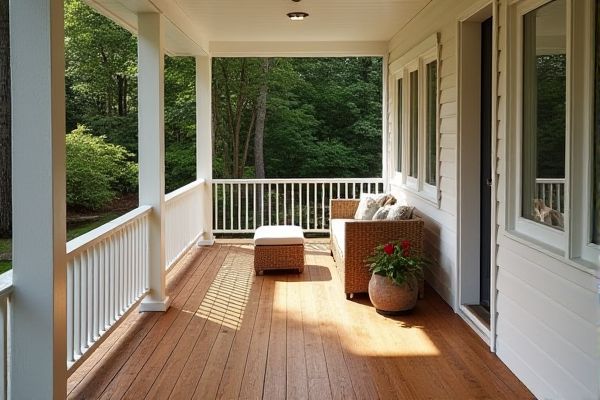
Composite decking offers superior durability, low maintenance, and resistance to rot and insects compared to traditional wood decking, which may require regular sealing and repairs. Explore the full comparison to determine which porch flooring option best suits Your lifestyle and aesthetic preferences.
Table of Comparison
| Feature | Composite Decking | Wood Decking |
|---|---|---|
| Material | Wood fibers + plastic resin | Natural hardwood or softwood |
| Durability | Highly resistant to rot, mold, insects | Prone to rot, insect damage, and weathering |
| Maintenance | Low; occasional cleaning required | High; regular sealing, staining, and repairs |
| Lifespan | 25-30 years or more | 10-15 years with proper care |
| Cost | Higher initial cost | Lower upfront cost |
| Appearance | Variety of colors and textures; consistent look | Natural wood grain; unique rustic look |
| Environmental Impact | Often made from recycled materials; less deforestation | Renewable resource; may contribute to deforestation |
| Installation | Easy with hidden fasteners; uniform boards | Requires skilled handling; varied board quality |
| Slip Resistance | Good, some products have enhanced grip | Varies; can be slippery when wet without treatment |
| Heat Retention | Tends to get hotter under sunlight | Maintains cooler surface temperature |
Introduction to Porch Flooring Options
Composite decking offers enhanced durability, low maintenance, and resistance to moisture, insects, and fading, making it ideal for porch flooring in diverse climates. Traditional wood decking provides natural aesthetics and can be more affordable initially, but it requires regular sealing, staining, and repairs to prevent rot and insect damage. Choosing between composite and wood decking depends on factors such as budget, climate, maintenance preferences, and desired longevity for porch flooring.
What is Composite Decking?
Composite decking is a durable building material made from a blend of wood fibers and recycled plastic, designed to mimic the appearance of natural wood while offering enhanced resistance to rot, splintering, and insect damage. It requires less maintenance compared to traditional wood decking, eliminating the need for staining, sealing, or frequent sanding. Ideal for porch flooring, composite decking provides long-lasting performance and eco-friendly benefits due to its use of recycled materials.
What is Wood Decking?
Wood decking consists of natural timber boards sourced from various tree species like cedar, pine, or redwood, valued for its classic appearance and organic feel. It requires regular maintenance such as staining, sealing, and cleaning to prevent rot, splintering, and insect damage. Your choice of wood decking influences durability, aesthetics, and maintenance level, making it essential to select the right type for your porch flooring.
Durability: Composite vs Wood Decking
Composite decking offers superior durability compared to wood decking, resisting rot, splintering, and insect damage with its synthetic materials. Wood decking, while aesthetically pleasing, requires regular maintenance such as sealing and staining to prevent warping and decay. Composite decks maintain their structural integrity and appearance for decades with minimal upkeep, making them a long-lasting choice for porch flooring.
Maintenance Requirements Compared
Composite decking requires minimal maintenance, needing only occasional cleaning with soap and water to resist stains, fading, and mold growth. Wood decking demands regular upkeep, including sanding, staining, and sealing annually to prevent rot, splintering, and insect damage. The long-term maintenance cost and effort for composite decking remain significantly lower compared to traditional wood decking.
Cost Comparison: Upfront and Long-Term
Composite decking typically involves higher upfront costs, averaging $30 to $45 per square foot, compared to wood decking, which ranges from $15 to $25 per square foot depending on the wood type. Over time, composite decking offers greater cost-efficiency due to lower maintenance expenses, as it resists rot, warping, and insect damage, reducing repair and replacement needs. Your long-term investment in composite decking can lead to savings despite the higher initial price, especially in climates prone to moisture and temperature fluctuations.
Aesthetic Choices and Design Versatility
Composite decking offers a wider range of aesthetic choices with colors and textures that mimic natural wood while resisting fading, staining, and warping over time. Wood decking provides a classic, authentic look that can be customized through staining and painting, allowing your porch to reflect traditional charm or rustic elegance. You can achieve greater design versatility with composite materials due to easier shaping and integration of unique patterns that maintain their appearance with minimal upkeep.
Environmental Impact of Both Materials
Composite decking significantly reduces environmental impact by utilizing recycled materials such as plastic and wood fibers, diverting waste from landfills and minimizing the need for virgin timber harvesting. Wood decking, while renewable and biodegradable, often involves deforestation and requires regular maintenance treatments that can introduce harmful chemicals into the environment. Lifecycle analyses consistently show composite decking offers greater sustainability benefits through longer lifespan and reduced resource consumption compared to traditional wood products.
Installation Differences and Considerations
Composite decking installation requires specialized tools like hidden fasteners and often involves precise spacing for ventilation and movement, reducing maintenance over time. Wood decking installation is typically straightforward, using nails or screws, but demands attention to sealing and spacing to prevent warping and decay. Consider the initial setup time and long-term upkeep when choosing between composite and wood decking for porch flooring.
Which Porch Flooring Should You Choose?
Composite decking offers superior durability and low maintenance compared to traditional wood decking, making it ideal for porches exposed to harsh weather conditions. Wood decking provides a natural aesthetic and can be more cost-effective upfront but requires regular sealing and staining to prevent rot and insect damage. Choosing between composite and wood porch flooring depends on budget, desired maintenance level, and long-term durability preferences.
 homyna.com
homyna.com